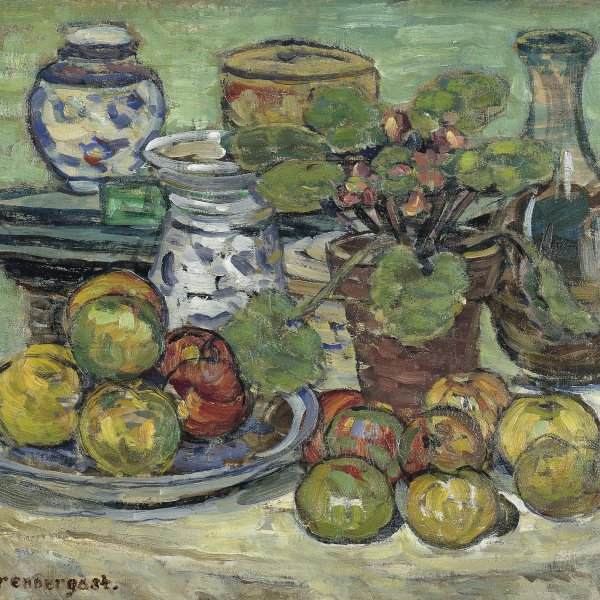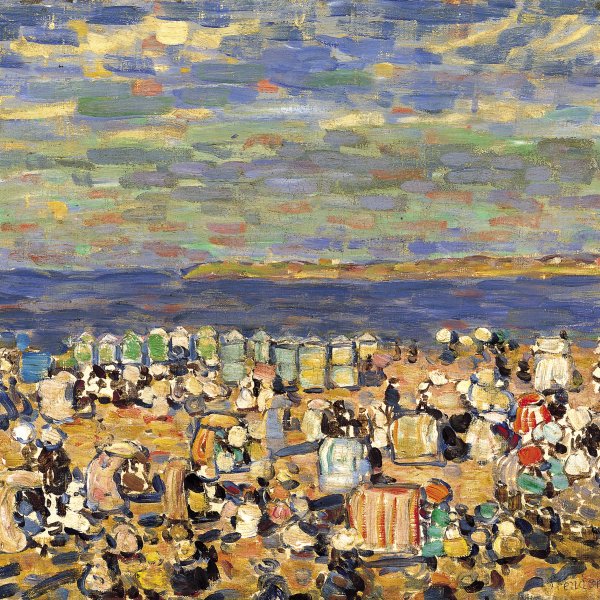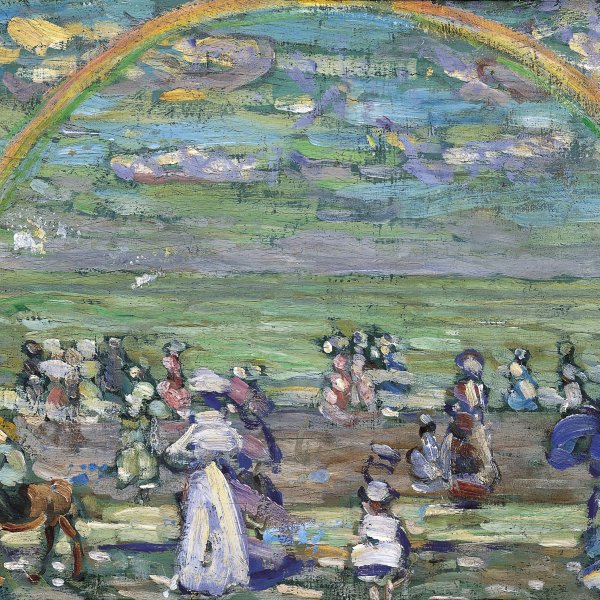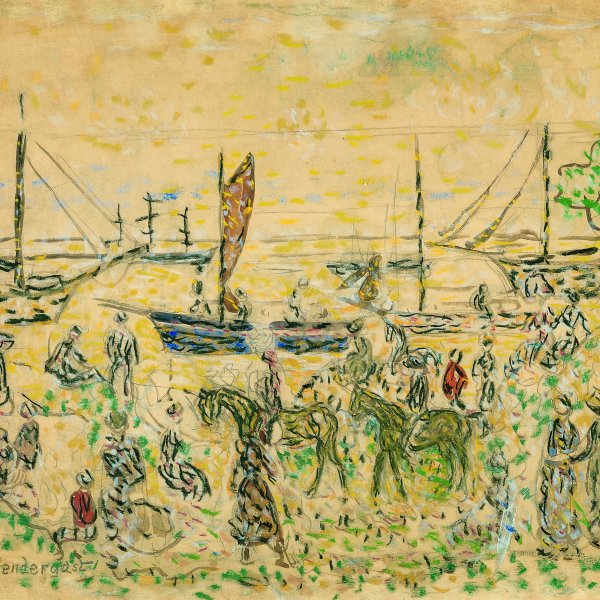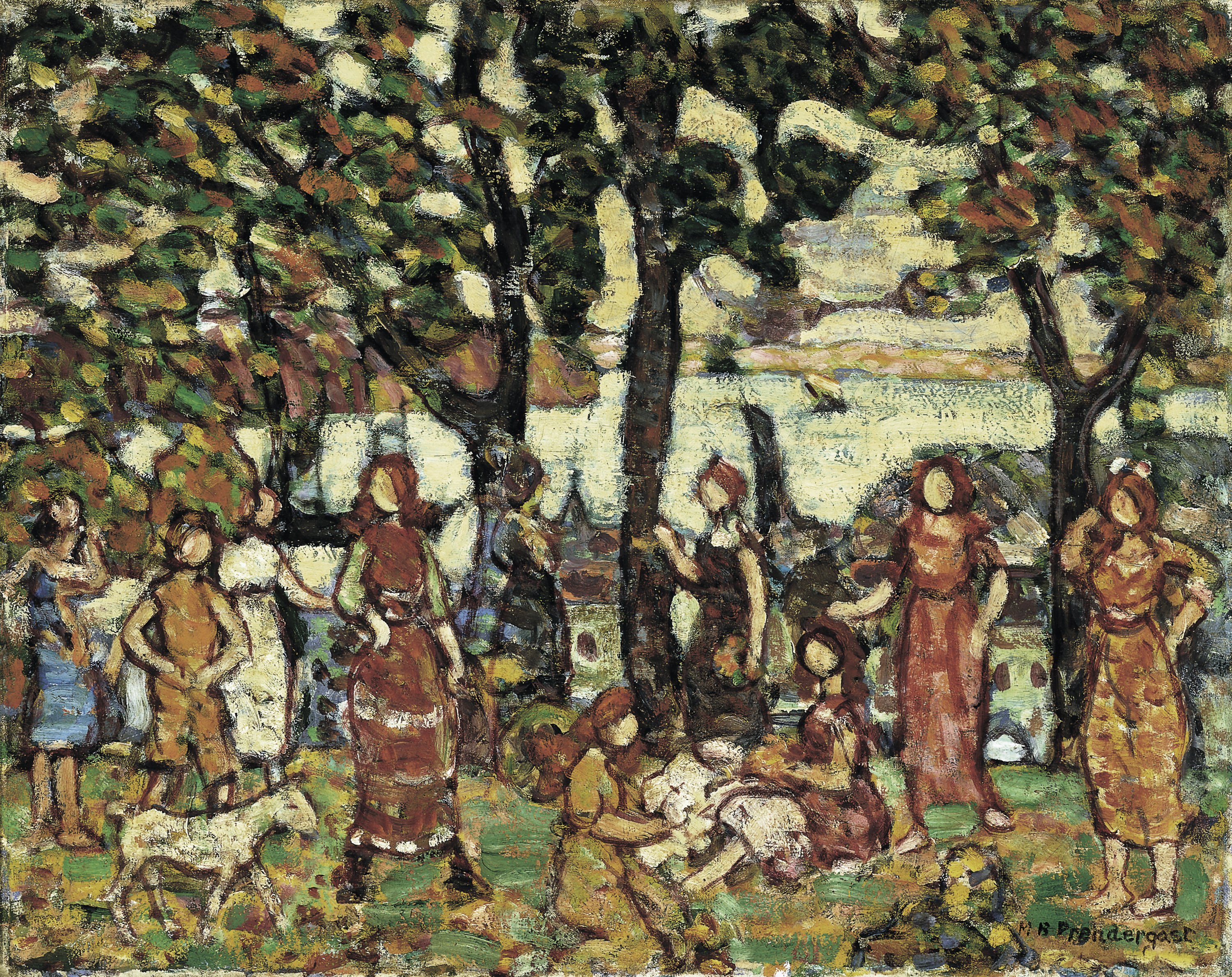Autumn
ca. 1918 - 1923
Oil on canvas.
49 x 62 cm
Carmen Thyssen Collection
Inv. no. (
CTB.1974.2
)
Room E
Level 0
Carmen Thyssen Collection and Temporary exhibition rooms
In Autumn only the russet tones in the foliage of the trees and the distant shore seen across the body of water indicate the season. Its compositional format, which was frequently used by Prendergast, shows a landscape laid out in broad horizontal bands against which is woven a rhythmic pattern of vertical accents. In the lower half of the painting an Arcadian frieze of standing female figures, anchored by two seated figures in the centre, spreads across the surface. The pronounced emphasis of the negative spaces between the trees, created by overpainting with lighter tones their dark leafy forms, unites with the light surface of the water, which itself was painted over a deeper hue. The colours of the figures' dresses echo the colors of the autumnal leaves.
Prendergast's numerous sketchbook drawings rarely relate precisely to specific paintings, but they offer insights into his creative process. Many of his compositional sketches are similar to Autumn and contain few or no figures, while other pages of his sketchbooks contain multiple drawings of figures, almost always female, both nude and clothed, with no indication of a physical environment. They suggest that the artist would create a landscape setting for his painting and then populate the composition with figures randomly chosen from his sketches. Often the drawings of clothed figures contain colour notations describing various aspects of their dress, less often were colours indicated in his landscape studies. As in his paintings, the features of his figures in his sketchbooks are generally anonymous. The dog-like figure in the lower left of Autumn is likely a hybrid of the various drawings which he made of donkeys pulling carts.
Autumn, c. 1918-1923, can be linked to a number of other landscapes by Prendergast, including Autumn Festival, c. 1914-1915, Washington (DC), The Phillips Collection, and Landscape with Figures, 1921, Washington (DC), The Corcoran Gallery of Art, whose dominant tonality is now green, but contains a similar dog-like form in the lower left of its composition. It has been suggested that a photograph of a Prendergast painting, preserved in an album of around 1918 in the Prendergast Archive, Williamstown (MA), Williams College Museum of Art, may be an earlier stage of Autumn. Prendergast often reworked his late compositions over a period of years, so that they became almost unrecognisable from their initial state. The photograph, however, relates far more closely to the Corcoran painting than to the composition in the Carmen Thyssen-Bornemisza Collection.
Autumn is a reductive variation of the Phillips and Corcoran compositions, distilled to densely-rendered forms, while at the same time retaining the festive joie de vivre found in the painter's late work. There is in the artist's paintings-as well as in the works of his brother, Charles-an innocent, child-like simplicity. "Prendergast sees the world, " a critic noted in 1915, "as a small boy might-an endless procession of men, women, and donkeys moving through the trees by the water's edge." The painting was previously dated c. 1910-1912 but has now been placed much later in the artist's chronology in the catalogue raisonné of Prendergast's works published in 1990.
Kenneth W. Maddox
Prendergast's numerous sketchbook drawings rarely relate precisely to specific paintings, but they offer insights into his creative process. Many of his compositional sketches are similar to Autumn and contain few or no figures, while other pages of his sketchbooks contain multiple drawings of figures, almost always female, both nude and clothed, with no indication of a physical environment. They suggest that the artist would create a landscape setting for his painting and then populate the composition with figures randomly chosen from his sketches. Often the drawings of clothed figures contain colour notations describing various aspects of their dress, less often were colours indicated in his landscape studies. As in his paintings, the features of his figures in his sketchbooks are generally anonymous. The dog-like figure in the lower left of Autumn is likely a hybrid of the various drawings which he made of donkeys pulling carts.
Autumn, c. 1918-1923, can be linked to a number of other landscapes by Prendergast, including Autumn Festival, c. 1914-1915, Washington (DC), The Phillips Collection, and Landscape with Figures, 1921, Washington (DC), The Corcoran Gallery of Art, whose dominant tonality is now green, but contains a similar dog-like form in the lower left of its composition. It has been suggested that a photograph of a Prendergast painting, preserved in an album of around 1918 in the Prendergast Archive, Williamstown (MA), Williams College Museum of Art, may be an earlier stage of Autumn. Prendergast often reworked his late compositions over a period of years, so that they became almost unrecognisable from their initial state. The photograph, however, relates far more closely to the Corcoran painting than to the composition in the Carmen Thyssen-Bornemisza Collection.
Autumn is a reductive variation of the Phillips and Corcoran compositions, distilled to densely-rendered forms, while at the same time retaining the festive joie de vivre found in the painter's late work. There is in the artist's paintings-as well as in the works of his brother, Charles-an innocent, child-like simplicity. "Prendergast sees the world, " a critic noted in 1915, "as a small boy might-an endless procession of men, women, and donkeys moving through the trees by the water's edge." The painting was previously dated c. 1910-1912 but has now been placed much later in the artist's chronology in the catalogue raisonné of Prendergast's works published in 1990.
Kenneth W. Maddox





